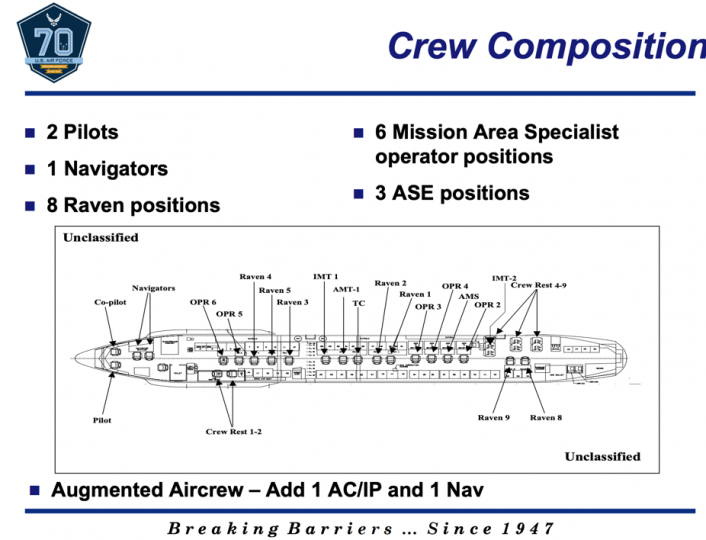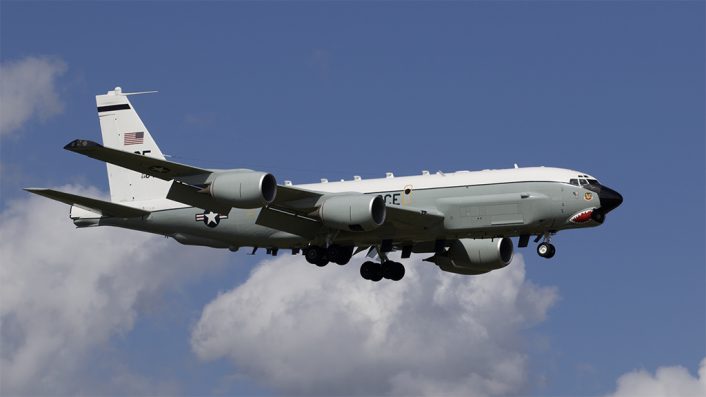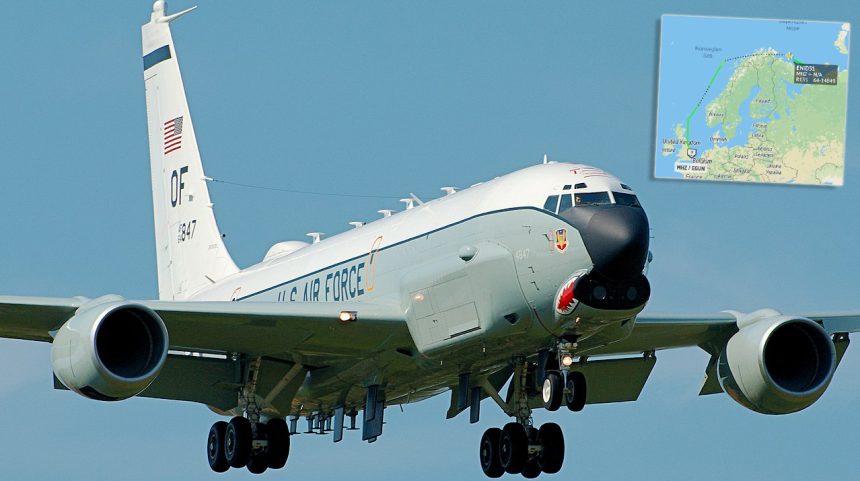Taken off from RAF Mildenhall, UK, the aircraft conducted an intelligence gathering mission off Murmansk, over the waters known to be exercise areas for the Russian Northern Fleet.
On Aug. 26, 2020, U.S. Air Force RC-135U Combat Sent, registration 64-14849, belonging to the 55th Wing, based at Offutt Air Force Base in Nebraska, but temporarily deployed to the UK, flew an 11h 20m mission over the Barents Sea.
The aircraft, radio callsign “ENID 51” flew outside Norway and reached the Barents Sea where it started flying several circles (actually, some uneven “racetracks” as usually done by reconnaissance and intelligence gathering aircraft) in international airspace off the Kola peninsula and the Murmansk region, that hosts some of the naval bases of Russia’s Northern Fleet.
The Combat Sent is one of the most secretive U.S. surveillance planes that can simultaneously locate, identify, and analyze multiple electronic signals. It provides strategic electronic reconnaissance information, performing signal analysis by means of a wide variety of commercial off-the-shelf and proprietary hardware and software, including the Automatic Electronic Emitter Locating System. The Combat Sent program was established on Apr. 17, 1970. Between 1971 and 1974, three RC-135C were converted to the RC-135U configuration: tail numbers 847, 792, 849. In 1975, tail 792 was converted to Rivet Joint, so from 1975 to present only two RC-135U remain operational.

Several things about this mission are worth of remark. First of all, the fact that the reconnaissance aircraft could be tracked online for most of its mission. Spyplanes, including the U-Boat (as the RC-135U Combat Sent is nicknamed in the pilot community), usually operate in “due regard” with transponder switched off, with no radio comms with the ATC control, using the concept of “see and avoid” where the pilot flying is responsible for avoiding all traffic conflicts. Even though RC-135U can be regularly tracked online, they tend to keep a low-profile when reaching some area of operations (such as the Barents Sea where they were rarely tracked in the past), turning off the ADS-B to avoid being detected at least by commercial ADS-B receivers like those feeding online flight tracking systems such as Flightradar24.com, PlaneFinder.net or ADSBExchange. In this case, the aircraft remained clearly visible. This visibility has allowed anyone using a web browser to clearly have an idea of the U-Boat’s area of operation that appeared to be unusually close to the Russian airspace (territorial sky is the nation’s sovereign airspace over territorial land and waters – that extend to 12NM from the coast).
#USAF 🇺🇸
64-14849 / #AE01D5 / #ENID51
RC-135U “Combat Sent”
Departed RAF Mildenhall – Barents Sea Ops #Murmansk #Russia pic.twitter.com/kl71E3R0mf
— SR Airband & Aviation 📡✈🌍 (@Andy007_SR_A) August 26, 2020
While, obviously, we can’t track all the missions the two RC-135Us fly around the world, yesterday’s mission was by all standards, close to the Russian airspace.
“It is not known what missile shootings or other activities the Northern Fleet is doing in the Barents- and White Seas on August 26, but an American spy plane does not normally fly so close to Russian air space for no reason,” the Barents Observer noted.
“By 11 am Norwegian time, the plane had made four or five circles over the waters from Russia’s maritime border to Norway in the west to outside the closed-down naval base Gremikha in the east.”
“These waters are well known for being exercise areas of the Northern Fleet, including rocket and missile launching. Russia’s Administration of Sea Ports of the Western Arctic has listed a few non-sailing areas for this week in the Barents- and Kara Seas, including an area marked for rocket shooting in the period from August 25-28. Another larger area is marked forbidden for navigation, but no reason are not announced. It could be an extension of a warning issued by Arkhangelsk Sea Port authorities covering larger areas of the White Sea and north to east of Cape Kanin. Warnings are issued when missile missile firings are to take place from Nenoksa test range near Severodvinsk or from navy vessels in the White Sea.”
“Russian missile firings are of interest to monitor by the Americans.”
The RC-135U mission just outside the Russia’s Northern Fleet bases took place amid increasing tensions in the Scandinavia and Baltic Region. Sweden has raised readiness in the Gotland area as a consequence of the Russian military activity. According to the Barents Observer, Russian landing ships were sailing close to the island of Gotland and Sweden responded by sending navy warships, soldiers and other military hardware to the strategically located island.
Actually, even U.S. special operations aircraft have been operating in the Gotland area these days:
US 67th Special Operations Squadron MC-130 landing on Gotland! What is going on? pic.twitter.com/gcs6nJtfkn
— Jamming (@balticjam) August 22, 2020
But the MC-130s are not the only U.S. assets in the region.
On Aug. 21, the U.S. Navy submarine USS Seawolf made a brief surfacing for personnel outside Tromsø in northern Norway. On Aug. 22, 6x B-52H Stratofortress bombers belonging to the 5th Bomb Wing, Minot Air Force Base, North Dakota, flew over the Norwegian Sea together with Royal Norwegian Air Force F-16 figther jets, on their way to RAF Fairford, UK, where they are going to be based for some weeks as part of a Bomber Task Force.
“We operate the B52s in 2 & 3-ship formations all the time, but flying 6 B52’s, 500ft off each other wings, co-altitude, while integrating w/ our Norwegian allies is by far the best thing I’ve done,” said Capt Andrew Dang, 23rd Bomb Squadron pilot. pic.twitter.com/4oLs7VDMRX
— AFGSC (@AFGlobalStrike) August 26, 2020
Back to the Combat Sent, on both Aug. 19, 20 and 24, the same RC-135U flew intelligence gathering missions (that could be tracked online) off Kaliningrad Oblast, in the Baltic region:
20 AUG: USAF RC-135U 64-14849 DUCHY61 departed Mildenhall at approx 0615z – Baltic mission pic.twitter.com/5oZeiJc3A9
— Mil Radar (@MIL_Radar) August 20, 2020
During the Aug. 24 mission the aircraft, flying as EPHOR 31, was also intercepted by a Russian Flanker:
”On Monday, a Russian Sukhoi Su-27 fighter jet scrambled to intercept unidentified aerial targets approaching Russia’s maritime borders spotted a Gulfstream reconnaissance aircraft operated by the Swedish Air Force, with US and German aircraft operating nearby.” Sputnikpropaganda
— Jamming (@balticjam) August 25, 2020
BTW, it’s worth of remark that the RC-135U was not intercepted – at least, no detail has been released thus far about an interception – when it flew off Murmansk on Aug. 26, 2020.

Anyway, as often reported, such intelligence gathering missions have been carried out for decades. The main difference nowadays, is that we get a chance to observe them from home…
A big “Thank You” to our reader Lasse Holmstrom for sending this over to us!









